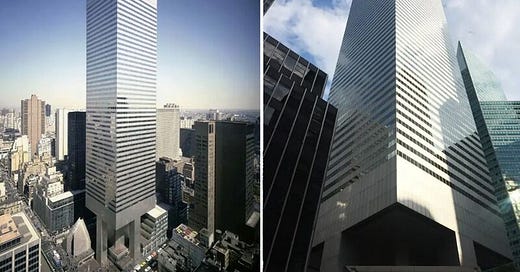The world's 7th tallest building had a design flaw that could cause it to collapse in a storm, and Hurricane Ella was bearing down on New York...
It became known as the Citcorp Engineering Crisis.
The story begins on a warm day in June 1978 when LeMessurier, one of America's leading structural engineers, received a call from an engineering student.
The student was assigned to write a paper on the Citicorp skyscraper and relayed their Professor's concern that the building's four columns were placed in the wrong position and that a strong enough wind would cause it to topple.
LeMessurier explained that the column positions were correct, positioned at the centre of each side and cantilevering the corners to provide space on the corner for the church from which the land was procured.
It provided a dramatic look that made the building seem like it floated above the street.
Furthermore, a 25,000-ton steel skeleton with braces was placed underneath the aluminium skin, absorbing all loads.
Building codes at the time required structural strength for perpendicular winds but not for winds from a 45-degree angle (quartering). So, in the spirit of inquisitiveness, after the student call, LeMessurier checked the calculations for these winds.
His calculation surprised him. In four of the eight braces in each tier, a quartering wind increased the strain by 40%.
Normally, this would be fine for a building design with adequate safety factors. Except, in this case, he knew the bracing welding joints had recently been changed to bolting during construction.
He now calculated that a 40% increase in tension meant a 160% increase in the bolts. Suddenly, the tower's safety factor dropped to a 1 in 16-year storm—a very dangerous situation.
The building did have the steadying influence of a tuned mass damper, which pushed the probability up to 1 in 50 years. But the machine required electric current, which might fail in a storm.
Luckily, the bolts in question were accessible from inside the building. So emergency contracts were handed out, welders qualified on the spot, and two-inch thick steel plates were welded over more than two hundred bolted joints - in a flurry of work.
Work carried on throughout every night in a race against time, with a hurricane named Ella on the way now.
But the work was done in time, the hurricane missed, and the building could now withstand a one-in-700-year storm, making it one of the safest structures ever built.
The whole story is a lesson in ethics
LeMessurier was the only one that knew of the problem and could have kept quiet. Yet, he risked his reputation, legacy and livelihood to do the right thing. Years later, he said this:
"You have a social obligation. In return for getting a license (as an engineer) and being regarded with respect, you're supposed to be self-sacrificing and look beyond the interest of yourself and your client to society as a whole"




